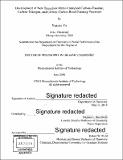Development of new transition metal-catalyzed carbon-fluorine, carbon-nitrogen, and carbon-carbon bond forming processes
Author(s)
Ye, Yuxuan, Ph. D. Massachusetts Institute of Technology
DownloadFull printable version (20.50Mb)
Other Contributors
Massachusetts Institute of Technology. Department of Chemistry.
Advisor
Stephen L. Buchwald.
Terms of use
Metadata
Show full item recordAbstract
Chapter 1. Palladium-Catalyzed Fluorination of Cyclic Vinyl Triflates: Dramatic Effect of TESCF₃ as an Additive A method for the synthesis of cyclic vinyl fluorides with high levels of regiochemical fidelity has been achieved by Pd-catalysis employing a new biarylphosphine ligand and TESCF₃ as a crucial additive. Five, six, and seven-membered vinyl triflate substrates, as well as a few acyclic substrates undergo the transformation successfully. The intriguing "TESCF₃ effect" provided a new tool for addressing the problem of the formation of regioisomers in Pd-catalyzed fluorination reactions. Chapter 2. Mechanistic Studies on Pd-Catalyzed Fluorination of Cyclic Vinyl Triflates: Evidence for in situ Ligand Modification by TESC₃ as an additive. A detailed mechanistic hypothesis for the Pd-catalyzed fluorination of cyclic vinyl triflates, and the unusual effect of TESCF₃ as an additive has been developed by combined experimental and computational studies. The preference of conducting [beta]-hydrogen elimination rather than reductive elimination from the trans-LPd(vinyl)F complex, which is generated predominantly due to the trans-effect, caused the poor regioselectivity of the fluorination reaction under TESCF₃-free conditions. An in situ ligand modification by trifluoromethyl anion, leading to the generation of the cis-LPd(vinyl)F complex which prefers reductive elimination rather than Phydrogen elimination, is proposed to be responsible for the improved regioselectivity of the fluorination reaction when TESCF₃ was used as an additive. Chapter 3. CuH-Catalyzed Enantioselective Alkylation of Indoles with Ligand-Controlled Regiodivergence A method for the enantioselective synthesis of either NI- and C3-chiral indoles by CuH-catalysis, depending on the choice of ligand, was developed. In contrast to conventional indole functionalization in which indoles are used as nucleophiles, hydroxyindole derivatives are employed as electrophiles in this method. DFT calculations indicated that the extent to which the Cu-P bonds of the alkylcopper intermediate distort, determines the regioselectivity of the reaction.
Description
Thesis: Ph. D. in Organic Chemistry, Massachusetts Institute of Technology, Department of Chemistry, 2018. Cataloged from PDF version of thesis. Includes bibliographical references.
Date issued
2018Department
Massachusetts Institute of Technology. Department of ChemistryPublisher
Massachusetts Institute of Technology
Keywords
Chemistry.